Teapots
Teapots
Tea originated in China as a medicinal drink over 2,000 years ago and was introduced into Europe during the 16th century by Portuguese priests and merchants. Drinking tea became fashionable in England during the 17th century and in time led to the English starting large-scale production and commercialization of the plant in India. At home, the English drank tea rather than coffee. 19th century inventories show that families owned twice as many teawares as coffee utensils. Women adopted the drink for their social gatherings and served tea after dinner. It was also an occasion to demonstrate wealth and good taste, and teawares were as responsive to changing fashion as dress and interior decoration.
Early teapots were of small capacity because of the rarity of tea. Although there are a few 17th century teapots in existence, there is little likelihood of finding one dating before 1710. The earlier the teapot the smaller they tend to be as tea was a very expensive commodity until the middle of the reign of George I
-


1716
Pierre Platel
10438 George I Antique Silver Teapot
A fine and rare early English silver teapot of bullet form with a simple ring foot and carved wooden fruit wood handle and finial. Lovely plain shape with a straight spout and small size. Early teapots were of small capacity because of the rarity of tea. Contains 550ml. Weight 461g, 14.8 troy oz. Height 11cm, 4.3ins. Spread 20cm, 7.8ins. London 1716. Maker Pierre Platel, Huguenot maker and master to Paul de Lamerie. Britannia standard silver, 95.8% purity.
-

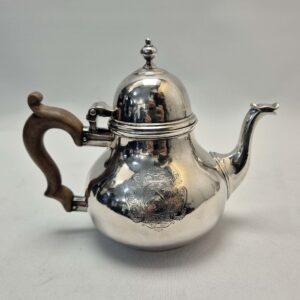
1721
Abraham Buteux
10434 George I Antique Silver Teapot
Reserved
An exquisite little early English silver teapot of pear shape, with octagonal curved spout and wood scroll handle. Good gauge silver. Hand engraved to the front within a decorative cartouche is a large contemporary armorial for the Shuckburgh baronetcy. Early teapots were of small capacity because of the rarity of tea. Early teapots were of small capacity because of the rarity of tea. Contains 450 ml. Weight (including handle) 383 grams, 12.3 troy oz. Height 14.5cm, 5.7ins. Spread 18cm, 7ins. London 1721. Maker Abraham Buteux. Sterling silver.
-

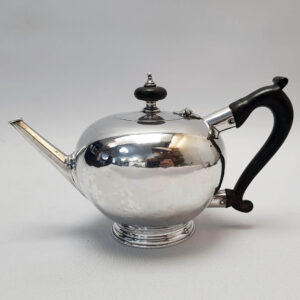
1725
William Atkinson
10407 George I Antique Silver Teapot
Sold
A fine little bullet shaped teapot of globular form with a plain body, straight spout, and wooden handle. Excellent quality and good gauge silver. Lovely patina and traces of the original hammered finish. Contains 550ml. Weight 352g, 11.3 troy oz. Height 11.6cm (to top of handle). Spread 20.2cm. London 1725. Maker William Atkinson. Sterling silver.
-

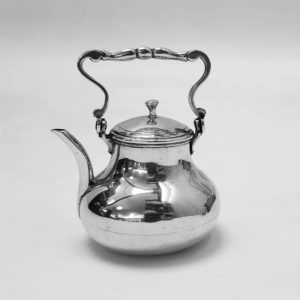
1737
Willem Van Strant
10116 Antique Dutch Silver Miniature Teapot
A Dutch silver toy teapot of pear shaped form with swing handle and detachable lid. Very good condition. Excellent patina. Weight 45 grams, 1.5 troy ounces. Height 5.5cm (to top of handle), 4.4cm (to top of knob). Made in Amsterdam, Netherlands. Date mark “C” for 1737. Maker Willem Van Strant.
-

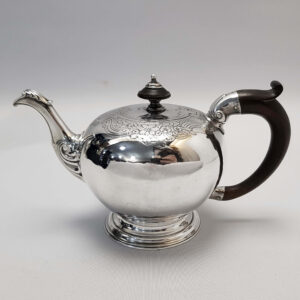
1742
Thomas Farren
10373 George II Antique Silver Teapot
An antique silver bullet shape teapot with the small size typical of the early date. Lovely plain shape with a curved spout and engraved decoration to the upper body. The lid has a good quality inset hinge. Contains 520ml. Weight 472g, 15.2 troy oz. Height 11.5cm. Spread 20.2cm. London 1742. Maker Thomas Farren. Sterling silver.
-

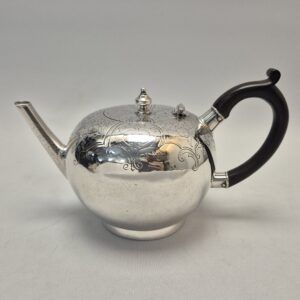
Circa 1749
David Hennell
8976 George II Antique Silver Teapot
An early English sterling silver teapot of globular form. Early teapots were of small capacity because of the rarity of tea. Lovely plain shape with a straight spout and applied ring foot. Nicely carved hardwood handle with a good grain. An attractive feature is the blobby mercury solder underneath which is completely original in the manufacture. The hand engraved decoration and initials are later done. Contains 650ml. Weight 372 grams, 11.9 troy ounces. Height 12.5 cms (to top of handle). Spread 20.5 cms. London 1749. Maker David Hennell I.
-

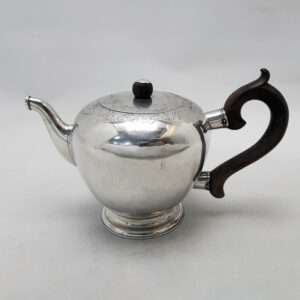
Circa 1750
Pierre de Moliere
10310 George II Antique Silver Teapot
A charming little bullet shaped teapot of plain simple form with a shaped panelled spout and wooden handle. Elegant small size. The bullet shaped teapot is typical of the George II period and this Swiss example shares all the quality characteristics including an inset hinge and cast silver foot. The lid is finely hand engraved with fruit, flowers and foliate scrolls. Contains 460ml. Total weight 368 grams, 11.8 troy ounces. Height 12.2cm. Spread 19cm. Lausanne, Switzerland. Circa 1750. Maker Pierre de Moliere.
-

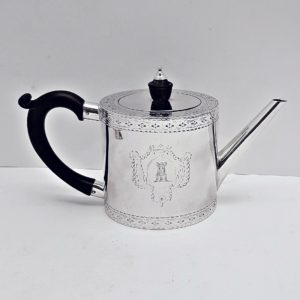
1775
Charles Wright
9544 George III Silver Drum Teapot
Sold
An antique sterling silver teapot of circular form with a pull off lid. Drum teapots are very desirable and are usually found between 1760 and 1780. Lovely plain styling with bright cut engraved and dot pricked bands with flower head motifs. To the front is a finely engraved crest within a decorate cartouche. Contains 700 ml. Weight 514 grams, 16.5 troy ounces. Height 13cm. Spread 23.5cm. Diameter 10.5cm. London 1775. Maker Charles Wright.
-

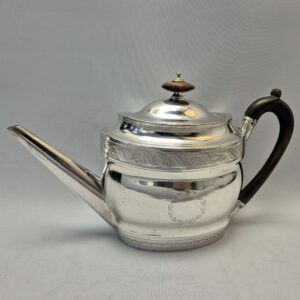
1800
Robert Jones
9616 George III Silver Teapot
An elegant antique sterling silver teapot of oval shapely form with bands of pretty bright cut engraving to the body, lid and spout. Simple classic design. There is a foliate cartouche engraved to the front and back, uninscribed. Teapot weight 496 grams, 16 troy ounces. Contains 1200 ml. Height 17.5 cm. Spread 29 cm. Base 12 x 8 cm. London 1800. Maker Robert Jones.
-

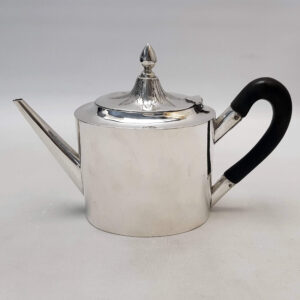
1804
10324 Antique Italian Silver Teapot
A very pretty antique silver teapot with plain oval shape and straight angled spout. Excellent quality. The raised lid is beautifully engraved with acanthus leaf ornament. Contains 700 ml. Weight 551 grams, 17.7 troy ounces. Height 15.7cm. Spread 22cm. Base measures 12 x 8.3cm. Naples, Italy. Circa 1804. 83.3% silver purity.
-

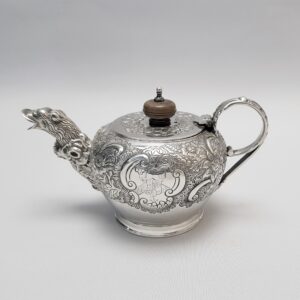
1821
Robert Gainsford
10377 George III Antique Silver Saffron Teapot
A very pretty antique silver teapot with deep embossed decoration. Small size. Good style with an ornamental animal head spout. There is a hand engraved armorial to the front and reverse sides. The interior has the original gilded finish. Contains 350 ml. Weight 327 grams, 10.5 troy ounces. Height 9.75cm. Spread 17.75cm. Sheffield 1821. Maker Robert Gainsford.